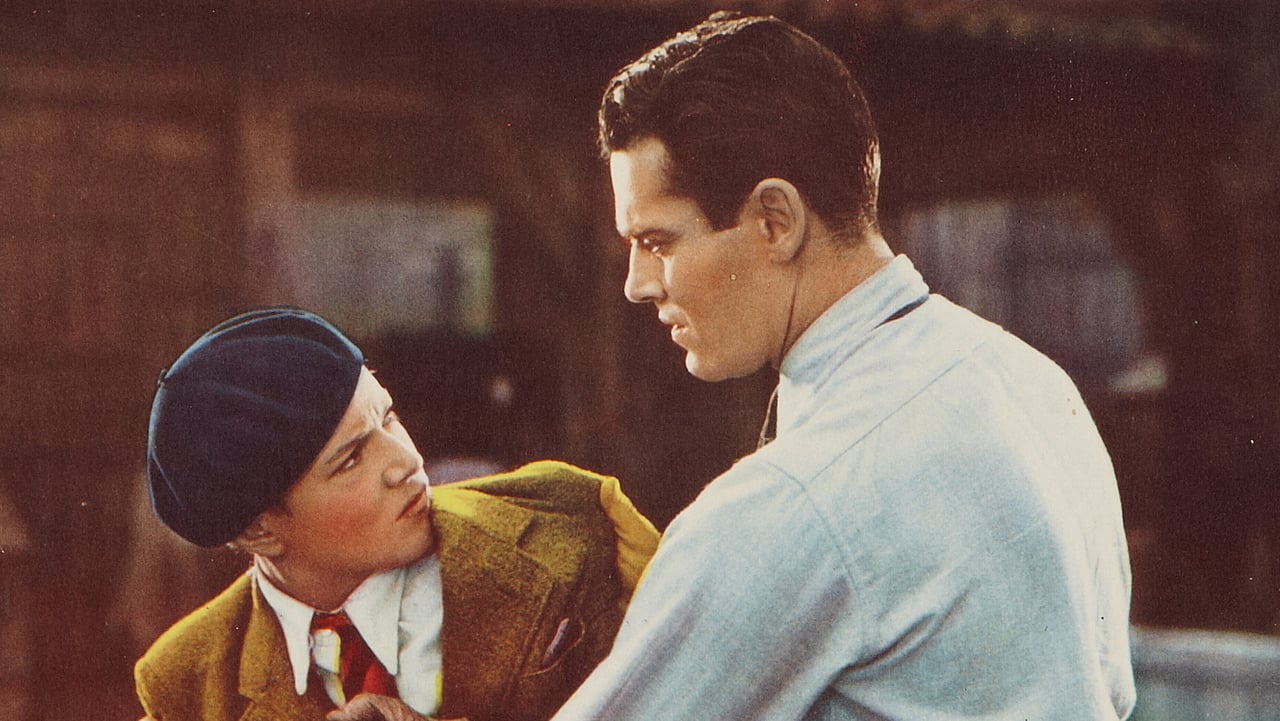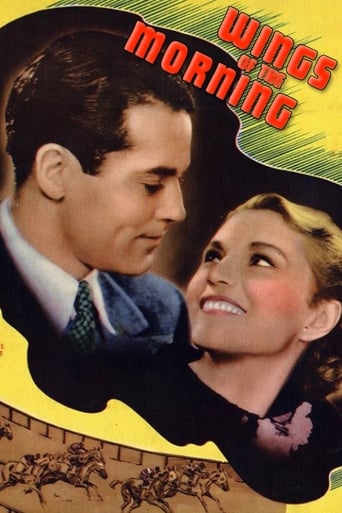

"Wings of the Morning" (1937) has the distinction of being the first Technicolor film shot in the British isles, made when the great cinematographer Jack Cardiff was operating a camera. It also introduced the Irish tenor John McCormack to the public. Wings of the Morning might have been important for being French actress Annabella's first English-speaking film, but Annabella was two years away from becoming very famous for another reason which basically stopped her film career.Annabella has a dual role here, actually a triple role, in a film that takes place first in the 1800s and then in the present day. First, she is Marie, a gypsy, who is with other gypsies in Ireland in 1869. The Lord Clontarf (Lesley Banks) gives the gypsies rights to live on his land in perpetuity. He falls in love with Marie and the two marry, a union that is definitely controversial. When Lord Clontarf is killed in a fall while riding, Marie jumps on the gypsy caravan, and ever the roamers, they leave the area.Fifty years later, Annabella plays Maria, Duchess of Leyva, who is Marie's great-granddaughter and engaged to Don Diego (Teddy Underdown). The gypsies must flee Spain due to a revolution, so they return to the Clontarf land in Ireland. Marie (now played by Irene Vanbrugh) is worried that Maria will not get out of Spain, but she does, dressed as a boy. While so dressed, she meets horse trainer Kerry Gilfallen (Fonda), a Canadian. Eventually he discovers he's a she and falls for her. Maria has traded her great-grandmother's horse, Wings of the Morning to Kerry, not realizing the importance of the animal. Marie intends to enter it in a race in order to win money for Maria's dowry.Henry Fonda was such a handsome young man, and always a good actor, but he doesn't come off as Canadian with that drawl of his. Despite being new to English, Annabella does a very effective job in all of her roles - she was, after all, a huge star in France. Singer John McCormack had a beautiful Irish tenor, but what a bore - no career in movies for him.As far as the film itself, it's an interesting story but in the end, not a great film. The color isn't as sharp as we're used to today, but it doesn't diminish the incredible beauty of the Irish countryside.Annabella met actor Tyrone Power on the set of Suez in 1938 and the couple married in 1939. Their boss, Darryl F. Zanuck, did everything he could to break them up -- he offered Annabella some films that were to be made in Europe -- but she refused to leave Power. Once they married, the star buildup for Annabella stopped. She would star on Broadway, work for the war effort, do radio, and a production of "Liliom" with her husband, finally returning to France after they were divorced in 1948. From what she said in interviews -- je ne regrette rien.
... View MoreIt's surprising to read everyone talking about the wonderful early British use of Technicolor for this film, when in fact the color photography (as seen in the print shown on TCM tonight) can best be described as murky, even in the close-ups.Aside from the color, the script is a garbled hodge-podge of strangely related events, clumsily crafted and given stiff acting even by the lovely ANNABELLA. For a better view of this French actress, I suggest you watch one of her later U.S. films called 13 RUE MADELEINE, to fully appreciate her acting abilities.The disjointed story, combined with the lackluster direction and the lame dialog, only undercuts whatever merits are in the film's script. ANNABELLA does nothing here to indicate that she's on the brink of better things in her future and her line readings are less than professional as delivered in her French accent.Why Technicolor was wasted on this below average story is a mystery to me. Fans of Annabella and Henry Fonda are sure to be disappointed. Fox would have been more successful if they'd filmed this horse story here in the U.S. in sunny California for both the interior and exterior shots.Surprised that this unrestored print was the best TCM could do.
... View MoreThis movie sets out to have much for many - and succeeds in a wacky, just relax and enjoy the utterly mixed bag way:the first Technicolor movie made in Britain (well, Ireland actually) a tale of gypsies and their generations-long curses all the sentiment and memories of the Auld Sod in Ireland three songs sung complete by John McCormack, the great Irish tenor horse racing tale - mixing in news footage of Derby Day in England love story between Henry Fonda and beautiful French sensation AnnabellaThere are odd moments - e.g., Henry Fonda forcefully removing all Annabella's clothes (behind a willow tree) until apparently repulsed, he realizes she's a girl and tosses her undergarments back to her - disgustedStrange scenes of "is she alive or is she dead" about an ancient gypsy woman. We're asked to accept that a living woman may easily life to see a fourth generation of her family -- in 50 years. In this movie, they apparently have an entirely new generation of gypsy children every sixteen years! (In contrast, I hope to marry next year and have children in future - yet my own grandparents were born in the 1890s, 110-120 years ago - without a fourth generation yet!). It's fun - and light, and romantic (annabella is really cute!) and it IS interesting to see John McCormack and the spectacular/sentimental scenes of Killarney - and to see a horse race at Ascot.Don't expect a classic - but it's a big fun jumble of stuff designed to appeal to many. Often a quite beautiful movie visually too.
... View MoreWings of the Morning is both the title of the film and the name of a gypsy horse who rides in the English Derby at Epsom Downs. It was the first modern technicolor film to be shot in the British Isles. To insure quality cinematographer Ray Rennahan who was THE color guy in Hollywood was brought over and he did a first rate job. I guess for good luck Henry Fonda who appeared in the first outdoor technicolor film in the USA came over to appear in this one. In the tradition of Americans appearing in British productions, Fonda plays a Canadian horse trainer with the Irish name of Kerry Gilfallen replete with his Nebraska twang.In fact most of this British production is shot in Ireland and I hope that Wings of the Morning is available to folks in Ireland in any format. Their country is really nicely captured in some really lush greens. And there is some nice color footage of London and the Epsom Derby in the middle Thirties.There are two stories, a brief prologue involving gypsy princess Annabella and the Irish Lord Clontarf played by Leslie Banks. They wed against all convention and soon after, Banks is killed in a riding accident. Of course most of the family snubs the widow and she returns to the gypsies.Fast forward some forty years and Annabella is now playing her own great granddaughter and she's back in Ireland having fled Spain from the revolution going on there. She flees like Katharine Hepburn did in Sylvia Scarlett, in the guise of a boy and fools everybody including horse trainer Henry Fonda. Of course the romance develops and a pair of horses get trained and primed for the Epsom Derby. Horse stories are no different in the UK then they are the USA and if you've seen enough of them on the silver screen you have an idea how the rest of the film goes.Champion jockey Steve Donoghue makes an appearance in Wings of the Morning and lucky indeed we are to have a technicolor filmed appearance of the great John McCormack who favors us with four songs sung at a party scene at Clontarf castle. McCormack was an icon in many an Irish and Irish American household. A great concert singer, he and an Italian tenor named Caruso share equal credit in developing the record industry as they both signed with Edison's fledgling RCA Victor label back in the day. You couldn't find too many Italian households without a Caruso record back in the day nor many Irish households without a gramophone and McCormack records to play on them.During his sequence McCormack sings and reads material, lyrics I'm sure he must have sang a gazillion times. My guess is that he was 53 when Wings of the Morning was made and may have been sustaining memory problems. McCormack died in 1945 and had not sung for several years at that point.Wings of the Morning were it not for McCormack and technicolor would be a rather ordinary race track story. Still it's good entertainment and for folks in Ireland, a must.
... View More